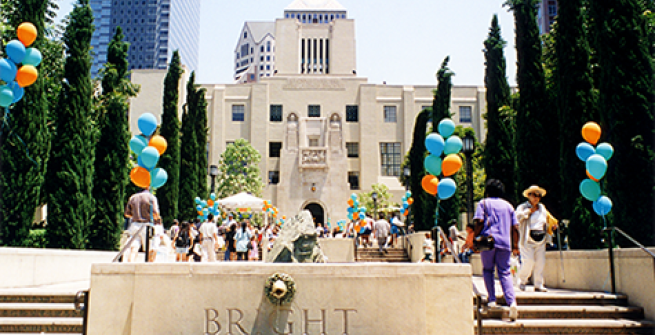The magnificent stairs at the Flower Street entrance of the Central Library have had several lives. Originally designed by the library’s architect, Bertram Goodhue in 1926, they were plain steps between three pools of plants and cool water. In 1968, after repeated requests by library employees, they were razed, along with the rest of the gardens, to build a parking lot. Fortunately for the library and all its patrons, the addition of the Tom Bradley Wing in 1993 afforded the opportunity to create underground parking, and resurrect the historic garden.
The central feature of what is now called the Maguire Gardens is once again the magnificent steps. These steps are now an art project known as SPINE, which is a double entendre: the spine that holds human beings together and the spine that holds a book together. Like a book, SPINE can be read from the endpapers of the scalloped entry points at the sidewalk level on Flower Street. The left side features archaic symbols, while the right steps feature post-literate images. The steps are the pages from the body of the book, while the sculptures in front of each pool are title or chapter pages.
Working along with librarians, artists Jud Fine and Harry Reese chose to decorate the steps in rising tiers, tracking the evolution of language. They started with non-alphabetic forms of communication, segued to alphabetic forms, and then returned to symbols. Here, in brief, are descriptions of the four sections of the eighty steps.
On the lowest level, the first step is blank to emphasize that the earliest humans left no written record of language. As we move up, we see the first markings of early humans, which first appeared on stone or clay in caves or on rocks. These are shown in dark red over dark bronze to imply the haziness of our understanding of these markings,
The second level indicates the emergence of alphabetical symbols. Black letters are shown on bright golden brass, depicting greater clarity and readability. On the left are the beginnings of both Asian and Latin-based languages. On the right is a series of languages beginning in biblical times, moving on to languages written in symbols. By this time, ink and paper had been invented, although printing was a slow meticulous one-page-at-a-time process.
The third level, which covers the age of enlightenment, is very readable white lettering on black background. What is particularly interesting are two “languages” that do not use words. On the left is math, the language scientists needed to explain the intricacies of the universe that were being articulated for the first time. On the right is a little music, that language of emotion, indicating that, for the first time, both math and music were also being written down just like words.
The third tier is also a nod to the invention of Gutenberg’s moveable type printing press, which enabled the world to move beyond handwritten words on bark, parchment, or cloth to typeset, printed pages that could be mechanically collated and bound into a book.
At the very top level, the steps lead us back to symbols again. On the left, we see shorthand, Braille, and Morse Code, while on the right, we see proofreading symbols, computer languages, and the definition of pi. The very last step is blank, symbolizing the unknowable future. Perhaps you will be the one to create the next language!
The three pools, which architect Goodhue named Bright, Lucid, and Clear, refer to the theme of the library, “The Light of Learning”. Each pool contains a sculpture of an animal, symbolizing three phases of evolution. The lowest pool, Bright, has a labyrinthodont, the earliest amphibian. The middle pool, Lucid, contains a California newt, greatly enlarged for artistic consistency and visibility. The top pool, Clear, features a Peregrine falcon. In 1993, this bird was on the endangered list but has since been repopulated. It serves as a magnificent metaphor that when we protect and preserve, whether it is a bird or a library, we preserve these treasures for future generations.
This is just a quick glimpse of SPINE. It’s a marvelous work of art and a never-ending look at the wonderful world of language and how its letters, shapes and sounds communicate ideas, feelings and, quite possibly, knowledge of ourselves.
Please join us for a docent-led tour of the Central Library.
